#yongzheng and qianlong are on here
Explore tagged Tumblr posts
Text
Ping Jinchuan: A 19th century Sci-fi Shenmo Novel
Like all popular novels, when something sets a trend, many imitators follow suit, until the formula becomes its own genre of sorts.
FSYY is one such genre setter. Specifically, the "Battle of Arts" (斗法) formula, where immortals and deities are added into a historical event——usually a war, but it can also be something like Admiral Zheng He's voyage——and proceed to use said setting as an excuse to battle it out using spells, magical treasures, and formations.
It's such an enduring formula, late Qing novels were still following it. And because it's the 19th century, western technology and ideas were entering China and making their way into popular culture.
My first exposure to the results comes from Legends of the Eight Immortal Attaining the Dao (八仙得道传), where the narrator occasionally interrupts the story and goes: "Electricity-based technology is totally the work of Mother Lightning, guys!"
Why am I telling you all these random facts? Because Ping Jinchuan ("Quelling the Golden Stream") is that, but turned up to eleven.
Technically, FSYY is set in Shang dynasty China. Technically, Ping Jinchuan is an obscure 1899 novel about the quelling of rebellions in Qinghai and Tibet during the 18th century by the historical general Nian Gengyao.
However, considering that FSYY has 11th century BCE gunpowder weapons, and...the entirety of Ping Jinchuan, I really doubt the claim of the latter novel's author that the story is based on the eye witness accounts of his ancestor, who worked as an advisor under Nian Gengyao.
But if you insist, here's a rough summary of the historical background: the first war Nian fought in Tibet happened during the reign of Kangxi, because the Dzungar Khanate invaded Tibet.
The second rebellion Nian quelled in Qinghai, during the reign of Yongzheng, was started by Lobzang Tendzin. He fought against the Dzungar Khanate with the help of Qing army, but rebelled together with local chiefdoms and Mongol leaders when he was not granted the rulership of Tibet afterwards.
(Confusingly enough, during the reign of Qianlong, there were also 2 other rebellions by the chieftains of "Greater and Lesser Jinchuan" in northwestern Sichuan, which might be where the novel's name came from.)
Naturally, the novel proceeds to tell a "Battle of Arts" story, about Tibetan Buddhist monks, Muslims, Daoist sages, and the leaders of the Roman Catholic Church duking it out with typical Shenmo novel treasures...and 19th century magitek.
There is potential for some serious analysis about Qing military expansion, violence on the frontiers, how foreign religions and people are perceived through the framework of popular fiction, etc. But honestly, after seeing the above summary, are you really here for *that*?
I'm not, because I don't know nearly enough about the historical context, and the entire premise is ridiculous enough to defy any attempt at taking it seriously——unless the attempts are ironic.
Case In Point
The novel starts off pretty tame: Lobzang Tendzin, "King of Jinchuan", wanted to send his own Dalai Lama candidate to Tibet after the previous Dalai's death, as part of a power ploy to make himself the de facto ruler of Tibet.
He allied himself with Galdan, the Dzungar ruler, to force the Tibetans to accept his candidate at gunpoint——literally.
Their firearms and cannons got stopped by a Lama named Ding Chan, who used his meditation power to summon divine warriors and fend off the first wave of attack.
However, his meditation was broken by the plight of Jinchuan soldiers disguised as female refugees, and later, Galdan assassinated him in his sleep with a firing squad during a treaty talk organized by the Qing.
Emperor Yongzheng was not happy and sent Nian Gengyao and Yue Zhongqi to quell the rebellion. Also, Nian is actually the Heavenly Dog Star incarnate, who learned martial arts, classics, war strategy, and all sorts of neat stuff in his youth from a poor Buddhist monk.
Later, said monk and Yue's master sent a bunch of their disciples to Nian and Yue as reinforcement, before the battle began.
Then, in Chapter 4, Nan Guotai was introduced as the fictional son of the historical Belgian missionary, Ferdinand Verbiest. Nicknamed "Little Lu Ban", he was well-versed in the arts of western machinery and firearms, and the first sign of the story going completely off the rails.
The first "Battle of the Arts" round was pretty standard——Five Phase Formation, magical breaths, treasures. But Nan was ordered to make 15 "mechanical carts" that could produce flames, in conjunction with a field of landmines, to assist in the breaking of the Five Phase Formation.
Despite the similarity, they aren't tanks, but more like...trapped cargo trailers/RVs. Basically, they had "doors and windows" with built-in mechanisms that only allowed entry into the carts and could not be opened from the inside, and once the enemies were trapped, the carts became giant incinerators.
After losing the first round, the King of Jinchuan put up a recruitment poster for "talented followers of the Three Religions"...except the Three Religions weren't Buddhism, Daoism, and Confucianism, but Islam, Buddhism, and Daoism, since the story is set in Qinghai, where there was a notable population of Hui people (Chinese Muslims).
After seeing the poster, Galdan's wife decided to seek help from her own master, the Patriarch of the Snowy Mountains. He is a Muslim sage with 12 powerful disciples...who all wielded typical Daoist treasures.
They all got overshadowed by the next round of Steampunk Shenmo Battle, though, when an unrelated Daoist showed up with his trump card: "Strong Water", a.k.a. magical hydrochloric acid.
The magical HCI was then put into giant glass syringes and fired at Nian's troops, resulting in significant casualties. To bypass the HCI syringe cannons, Nan unrevealed his latest invention: the Skysoar Orb, a.k.a. hot air balloon.
The Qing troops then mounted firearms and cannons onto the air balloon, flew it above Galdan's camp to a height where the HCI syringes couldn't reach, and started shooting. However, they were all mortals, and got decimated when the enemy immortals flew up to take control of the balloons, forcing an emergency landing via needles.
After that, the hot air balloon was manned entirely by immortals, until Galdan covered his camp in a mesh of barbed wires, blocking the aerial fire but also making it impossible for him to use his own HCI syringes.
Then a little 13 years old immortal, Gengsheng the Acolyte, joined the Qing army, who's the reincarnation of the Lama executed by Galdan's firing squad. Abandoned at birth and adopted by a Daoist master, he was able to fly on clouds since he was 8-9 years old, which he used to travel to Europe.
While he was there, a Swedish sage gifted him a powerful treasure——the Electricity Whip, which can be used to electrocute people to death...but also magically heal injuries with its currents.
I have trouble visualizing the thing. Is it a literal whip of lightning arcs (since it's described as being able to turn into a white beam), a taser, an electric cattle prod, a plasma whip, or the unholy lovechild of all the above plus a tesla coil?
Hilariously, the Electricity Whip treasure of the Nikola Tesla Sect (/sarcasm) stopped working when exposed to "dirty stuff" such as a woman's magical handkerchief. Classic folk magic style.
After a bunch of boring fighting sequences, 6 of the 12 disciples of the Patriarch decided to get the big formations out, which were broken by buckets of pig blood.
…Yeah, that's pretty much the extent of the author's understanding of Hui customs and Islam. (sigh) The surviving disciples went to get the Patriarch for help, who casted an AOE spell of poisonous smoke, water and fire to block the Qing troops' path...
Annnnnd Nan to the rescue again! With the help of Nian Gengyao's monk master, he built the Earth Travel Cart: a magitek subway train shaped like a pangolin, able to carry a hundred people and move a hundred Li per hour. It didn't need rails, you just dug a hole in the ground, put the train in, and it started tunneling through the earth on its own.
The entire army used 500 of these magical subway trains to bypass the Patriarch's AOE spell coverage, forcing them to retreat to their home base, Tianshan (Heavenly Mountain). Which is a real mountain range in central Asia and Xinjiang province, and going there from Qinghai is plausible. Kinda.
I'm still skeptical about the novel's claim that the path through Tianshan is the only path leading into Jinchuan proper, but whatever.
The Patriarch put his most powerful formation on said mountain pass——the Ice Freeze Formation, which will insta-freeze immortals, mortals, and flying birds alike when they step in range.
Then comes the craziest part of the entire novel. Honestly, everything after this chapter is pretty boring and formulaic, which makes it the perfect note for this article to end on.
Nan suddenly revealed that the current Roman Pope is the grandson of Matteo Ricci, who's the mentor of Nan's dad, and took his hot air balloon to Rome to get reinforcement. To no one's surprise, the Pope's treasure is a cross.
The Pope agreed and took his 12 disciples——supposedly because it's the same as the number of apostles——to the snowy mountain.
He gave a cross and a white candle to each of his disciples; they walked straight into the Ice Formation and broke it by holding the two holy objects up in the air, while loudly chanting (a highly localized translation of) "Hail Mary!"
After making his grand entrance, the Pope neutralized the Patriarch's spell attacks and turned his last disciples' army of soldiers back into their true forms——a bunch of farm animals.
He then told the disciples that as the Roman Pope, he had authority over "Russia, England, France, Netherlands" and all the European nations, and he'd leave the Patriarch to mind his own business if he surrendered and stopped interfering in the war.
Three of the four examples he gave aren't even Catholic, but maybe the Protestant Reformation just never happened in this novel's 18th century world because Pope Magic.
The Patriarch accepted the cease-fire treaty, went back to teach his religion to the population of northwestern China, and that's pretty much it. His last female disciple (Galdan's wife) got her troops' firearms neutralized by the Pope's cross, taken prisoner, and executed by Nian.
After revealing that the Qing immortals' power also came from the Grace of Our Lord and Savior, and that was why westerners couldn't use spells (but could make electricity-based treasures?), the Pope flew back to Rome on Nan's air balloon, exiting the novel once and for all.
Which is a pity, because in the second half of the novel, one of the defeated foes escaped to (Ottoman?) Turkey to beg their king for reinforcement, and the Russian Tsar agreed to help the Jinchuan troops to make his French wife happy. I want my Papal 13 vs. Russian Orthodox Bishops Shenmo battle, dammit!
Food for thought: if the Pope was Matteo Ricci's grandson, and Matteo Ricci was also a mentor of Ferdinand Verbiest, Nan's dad (historically, Ricci died 13 years before Verbiest was even born)...
...Is this a timeline where the Jesuits won the Rites Controversy, Ricci cultivated himself into the first Catholic immortal, and ushered in the age of Syncretic Daoist-Catholic Steampunk?
#chinese folklore#chinese literature#steampunk#chinese novels#catholic church#daoism#buddhism#chinese history#islam#matteo ricci#jesuits#qing dynasty#investiture of the gods#fengshen yanyi#how do you even tag this novel#the sheer unhinged fun of it all
53 notes
·
View notes
Note
Hello again, this time my question is in the ranking of concubines in the Qing dynasty, specifically in two: the ladies-in-waiting and the mistresses.
Recently, while looking at the women who were part of Emperor Qianlong's harem, I saw that he had two mistresses and a lady-in-waiting, and it was then that I became curious to know more about that position, which was even more inferior than a daying: "Lady- in-waiting (官女子; guānnǘzǐ) was typically used to refer to all the women working in the palace. I didn't see anything talking about the lovers so I didn't put the excerpt here.
So, can we say that these women served the emperor but were not officially accepted? Would their treatment be different from servants who didn't do this? If by chance they got pregnant, would it be made official or would their children be given to another consort to raise?
This depends on what the source you’re referring to means by “two mistresses and a lady-in-waiting”. Sometimes more dated sources would lump all positions under pin to be mistresses which also sometimes taken to be synonymous with “lady-in-waiting” whatever that is (Daying? Guannuzi? A maid who doesn’t have proper recognition? Who knows.)
I mean, I see lady-in-waiting and I sort of think just a regular palace maids which any emperor would have dozens of waiting on him, and he doesn’t sleep with all of them (though technically he could).
Anyway, about guannuzi - tl;dr: as a rank, they’re senior maids, and they can wait on the emperor overnight either in the most literal sense in that they’re standing there in wait, or as in the emperor does sleep with them but they’re still expected to perform duties of a servant.
Anyway, if a palace maid got pregnant by the emperor, the honourable thing for the emperor to do would to give them a title and recognition, mostly because that also gives legitimacy to provide the pregnant woman with help and adequate care, and as emperor you’re supposed to show that you at least care enough for your child to take care of the pregnant mother. Dramas like Zhen Huan and Ruyi sort of made it seem like Yongzheng just ignored(?) Hongli’s birth mother who was a palace maid and never gave her any recognition or title, but I doubt that would actually fly in real life, because if the mother had no recognition or title, Yongzheng couldn’t have recognised Hongli himself. Of course it’s also implied that Hongli was shoved to the side and hidden away for half of his life, but the whole palace still knew that a “Si Ah Ge” existed so he was given recognition as a child of Yongzheng before he was written down as Xi Fei’s son. I think realistically it would have been difficult for Yongzheng to have recognised him however reluctantly and distantly, and still completely disregard his birth mother while also not even bothering to have another consort/concubine act as his mother, because that would have been extremely damaging to his reputation and any emperor would probably care more about than what was implied in the drama that everyone knows and gossips about it and the emperor is just sort of…out sight out of mind about it.
13 notes
·
View notes
Text
CHINA, 14 DAYS 🇨🇳
China is the largest of all Asian countries. Occupying nearly the entire East Asian landmass, it covers approximately one-fourteenth of the land area of Earth, and it is almost as large as the whole of Europe. China is also one of the most populous countries in the world, rivaled only by India, which, according to United Nations estimates, surpassed it in population in 2023.
China has 59 UNESCO World Heritage Sites, ranking second in the world, just below Italy (60).
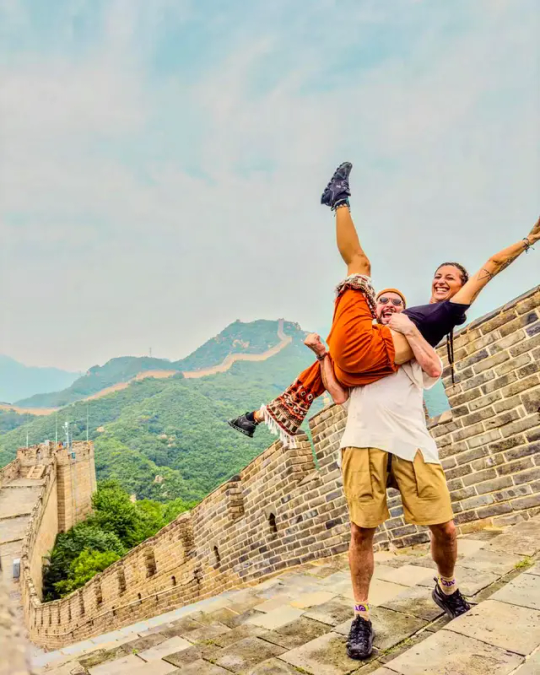
TIPS BEFORE DEPARTURE
Do not book hotels on Booking - use Trip.com where you can find many more acomodations with a cheaper price!
Trains are the best transport to use while visiting China. You can easily book them on Trip.com
It's necessary to download translator apps: nobody talks English so you need to translate everything by yourself. I suggest ARTraduttore and DeepL
It's also useful to download other apps before departure: Alipay and WeChat - with these 2 apps, you can easily book tickets for attractions and you will be able to pay everything and everywhere.
Download Didi: it's like Uber and it's super useful for short transfers in the cities. Cheap and essential!
Make sure to buy all the attractions on time (in high season tickets for attractions are often sold out).
Don't plan too many things every day: distances are huge and sometimes it's impossible to do everything you planned.
DAY 1-2 / BEIJING
From ancient walled capital to showpiece megacity in barely a century, Beijing (Běijīng, 北京), spins a breathless yarn of triumph, tragedy, endurance and innovation.
the history of Beijing which dates back 3 millenniums, making the Chinese capital one of the oldest cities in the world.
WHAT TO VISIT (FIRST 48H)
Temple of Heaven, large religious complex in the old outer city of Beijing, considered the supreme achievement of traditional Chinese architecture. Its layout symbolizes the belief that heaven is round and earth square. The three buildings are built in a straight line. The Hall of Prayer for Good Harvests (1420) has three concentric circles of massive wood columns symbolizing the four seasons, 12 months, and 12 daily hours; in a remarkable feat of engineering, they support the three roof levels and, in succession, a huge square brace (earth), circular architrave (heaven), and vast interior cupola.

Lama Temple: Lama Temple, also named Yonghe Lamasery, is Beijing's principal and largest Buddhist Temple. It was built in 1694, as part of the city wall for Emperor Yongzheng, prior to him rising to the throne in 1722. Yongzheng’s son - Emperor Qianlong, sent for 300 Tibetan monks and 200 Chinese students and housed them in the palace in 1744. From then on, the dwelling served as a temple and monastery, and considered one of the greatest centres of Buddhism outside of Tibet. The temple has five main halls, each soaring over the one before, with clockwise changing prayer wheels, multicoloured tiles, lion statues and deep within the largest wooden Buddha in the world. Visitors are encouraged to purchase and burn joss sticks at the site to worship Buddha. By far one of the cities most impressive and fascinating temples, you could spend a whole day here enjoying the breath taking statues and artefacts.
DAY 3-4 / CHENGDU
Chengdu is the original city name which dates back to its founding over 2000 years ago. Chengdu is the capital of southwestern China's Sichuan province, as well as one of the largest cities and the most important economic, financial, commercial, cultural, transportation, and communication centers in Western China with a population of more than 14 million. The city is famed for its cuisine, and is also home to the famous Chengdu Research Base of Giant Panda Breeding, a conservation center where visitors can view endangered giant pandas in a natural habitat. Chengdu also hosts more than 260 Fortune 500 companies. In 2006, it was named China's 4th most livable city by China Daily. The fertile Chengdu Plain, on which Chengdu is located, is also known as the “Country of Heaven,” a phrase also often translated as “The Land of Abundance.”

3 MUST-DO
Visit the Panda Center 🐼 The Chengdu Research Base of Giant Panda Breeding is a public non-profit breeding and research institute for giant pandas, red pandas, and other rare animals, located in Chengdu, Sichuan.
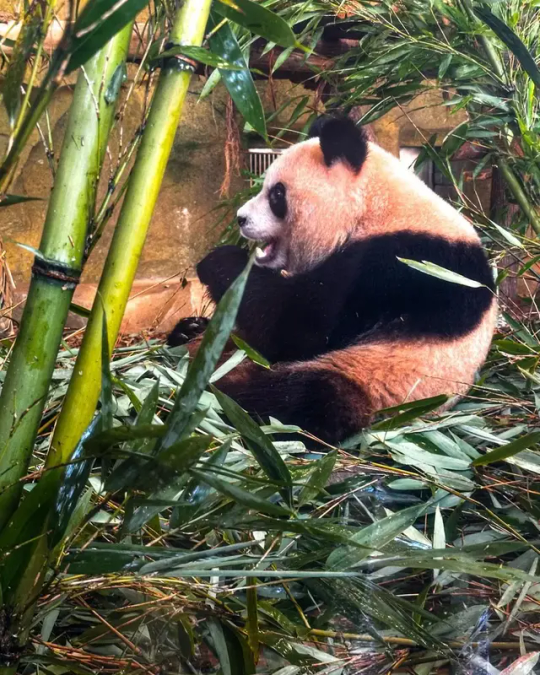
Go to Leshan and visit the Giant Buddha of the World. In 713, a monk named Hai Tong decided to carve a Maitreya Buddha statue to watch over the river, a project that took 90 years, until 803, to fully complete. The resulting Buddha was immense: Its fingers are 27 feet (8.3 m) long and the shoulders are 92 feet (28 m) across, nearly the size of a basketball court. At 23 feet (7 m) long, the ears, made of wood covered in mud, were attached to the sculpture in a wonder of ancient engineering. The statue was originally sheltered by a 13-story wooden structure but this was destroyed during the Ming dynasty.

Try the Tea experience in a traditional Tea House 🫖
We stayed at FlipFlop Hostel. We really loved the atmosphere and the staff was super helpful with us.
DAY 5 / CHONGQING
Chongqing, city (shi) and provincial-level municipality (zhixiashi), southwest-central China. The leading river port, transportation hub, and commercial and industrial centre of the upper Yangtze River (Chang Jiang) basin, the city is located some 1,400 miles (2,250 km) from the sea, at the confluence of the Yangtze and Jialing rivers. During the Sino-Japanese War (1937–45) it was the capital of Nationalist China. The city was named Chongqing (“Double-Blessed”) in 1189 under the Nan (Southern) Song dynasty (1127–1279 ce). At that time the city occupied a commanding position between the prefectures of Shunqing (centred on modern Nanchong) to the north and Shaoqing (centred on modern Pengshui) to the east.
3 MUST-DO:
Go to Liziba station: As the first overhead station built across and packed with skyscrapers, it has been honored and known in the world since its inception. Any visitor on his first trip here, whether sitting in the train or looking up from the viewing platform, can be amazed when watching the train “disappearing” through the high-rise block. It is no accident that Liziba became a China’s 70-year Growth Landmark. Embedded with the wisdom of connecting apartments with light-rail transit, Liziba takes the lead in pushing the Mountain City’s public transport forward, without a stop. Besides this incredible transport, Liziba is full of gentle and tough stories.
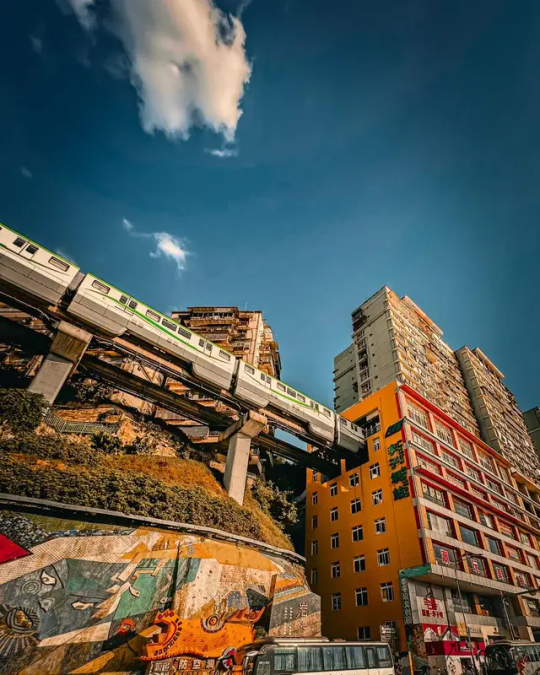
Go visit the Chongqing Bookstore
Go to Hongyadong, enjoy a walk inside and have a Hotpot there, the typical dish of the city. Hongyadong has witnessed the tides of history and weathered the centuries to blossom into the huge tourist attraction it is today. Until around merely 20 years ago, Hongyadong was home to the working class of Chonqing and its distinctive stilted buildings (unique to Southwestern China). After a renovation in the 90s, the spirit of Chongqing’s hardworking people has been kept in a new dazzling form. Visitors can enjoy the unique multi-level Chongqing-style architecture of centuries before, while shopping, eating and playing, all the while being swept away by the breathtaking riverside views of the city, and of Hongyadong itself - which has been lit up with a thousand lights.Since the rapid development of the Internet, Chongqing has become one of the hottest cities, which attracts people to visit.

We then spent the night at Futon, the best hotel room we have been. We enjoyed the huge bath inside the room with an amazing view on the city lights and skyscrapers✨
DAY 6 / CHENGDU
After a nice breakfast in Chongqing we came back to Chengdu and we enjoyed a relax afternoon. Here what we did:
We tasted the famous Mapo Tofu and the super spicy cuisine 🌶️🌶️🌶️
We experienced a real Chinese massage in a very fun way. We went to R&F mall to a massage center named Golden Impression and we watched a 90 min movie in a private room with a full body massage 😍
Then we spent the night at Buddha Zen Hotel and we had drinks in a karaoke bar nearby 🎤
DAY 7-8 / XI'AN
Located in the middle of the Guanzhong Plain, Xi'an is one of the three international metropolises and the 9th Regional Central City of China designated by China's central government. It has earned the honorary titles of National Sanitary City, National Garden City, China City with Best Images, China City with Best International Images, and China's Civilized City. Remarkably, it has been named China Happiest City seven years in a row.
Xi'an was the ancient capital of China and a cradle of civilization together with Athens, Cairo and Rome. It was the starting point of the ancient Silk Road. As a famous historical cultural city, Xi'an boasts the world’s richest cultural heritage and the most complete preservation of the ancient city and moat system. With more than 7,000 years of civilization, more than 3,100 years of city building and over 1,100 years of capital establishment, Xi'an can justly be called an "Open Air Historical Museum"; and indeed it has a total of 126 museums. The Qin Shihuang Mausoleum Terracotta Warriors and Horses, Big Wild Goose Pagoda, Little Wild Goose Pagoda, Tang Chang'an City Daming Palace Site, Han Chang'an City Weiyang Palace Site, and Xingjiao Temple Pagoda have all been inscribed in the World Heritage List.
3 MUST-DO:
More than 8000 warriors + 100 horses + 18 chariots. The terracotta army is a collection of terracotta sculptures depicting the armies of Qin Shi Huang, the first emperor of China. It is a form of funerary art buried with the emperor in 210–209 BCE with the purpose of protecting him in his afterlife. The Terracotta Army was discovered on March 1974 by a group of farmers—Yang Zhifa and his five brothers.
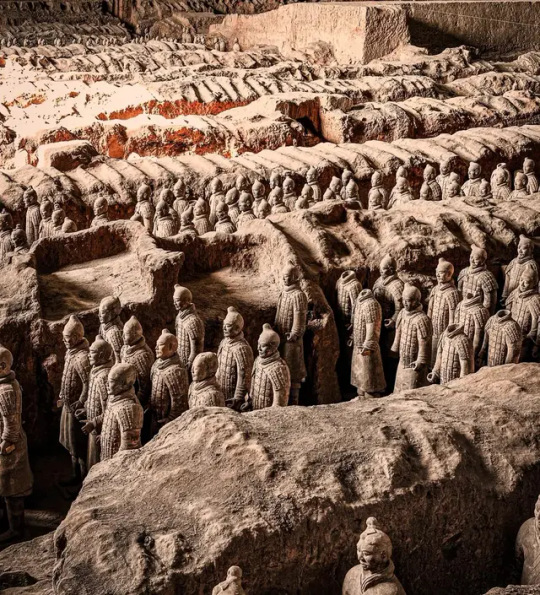
Walk through Xi'an ancient fortification walls. Xian Ancient City Wall is the landmark and a must-see attraction in Xian which stretches round the old city. Built by Zhu Yuanzhang, the first Emperor of the Ming Dynasty, the city wall is the most complete city wall that has survived in China and one of the largest ancient military defensive systems in the world.
Explore the Muslim neighbourhood and enjoy a street food tour. Don't forget to visit the Bell Tower, Drum Tower and Goose Pagoda 😉
DAY 9-10 / GREAT WALL
In c. 220 B.C., under Qin Shi Huang, sections of earlier fortifications were joined together to form a united defence system against invasions from the north. Construction continued up to the Ming dynasty (1368–1644), when the Great Wall became the world's largest military structure. Its historic and strategic importance is matched only by its architectural significance. The Great Wall was continuously built from the 3rd century BC to the 17th century AD on the northern border of the country as the great military defence project of successive Chinese Empires, with a total length of more than 20,000 kilometers. The Great Wall begins in the east at Shanhaiguan in Hebei province and ends at Jiayuguan in Gansu province to the west. Its main body consists of walls, horse tracks, watch towers, and shelters on the wall, and includes fortresses and passes along the Wall.
We didn't go to Badaling, as it was too crowded. We preferred to spend the night at Yueli Homestay Delight Inn and enjoyed the Great Wall from Shuiguan (very closed to Badaling anyways). We drove with Didi - the 1h drive cost us 30€.

DAY 11-12 / BEIJING (LAST 48H)
Once we came back to Beijing we enjoyed other attractions of the city, restaurant and shopping
We visited the Summer Palace. The Summer Palace in Beijing – first built in 1750, largely destroyed in the war of 1860 and restored on its original foundations in 1886 – is a masterpiece of Chinese landscape garden design. The natural landscape of hills and open water is combined with artificial features such as pavilions, halls, palaces, temples and bridges to form a harmonious ensemble of outstanding aesthetic value.
We got a tour on get your guide and visited Tiananmen Square and the Forbidden City. Forbidden City, imperial palace complex at the heart of Beijing (Peking), China. Commissioned in 1406 by the Yongle emperor of the Ming dynasty, it was first officially occupied by the court in 1420. It was so named because access to the area was barred to most of the subjects of the realm. Government functionaries and even the imperial family were permitted only limited access; the emperor alone could enter any section at will. The 178-acre (72-hectare) compound was designated a UNESCO World Heritage site in 1987 in recognition of its importance as the centre of Chinese power for five centuries, as well as for its unparalleled architecture and its current role as the Palace Museum of dynastic art and history.
Tiananmen Square 🫶🇨🇳
Some Restaurants:
King's Joy, the cheapest 3-michelin- stars restaurant of the World.
Our very very favourite restaurant is Fu Hui Ci Yuan, an incredible vegetarian restaurant.
Try the Duck at Sinji Minfu - it takes a while to wait but Edo said the duck really worths?
DAY 13 / BACK TO MILAN ✈️
We booked a direct flight Milan-Beijing and Beijing-Milan on Airchina.
Text me, if you want to have the complete excel file.
0 notes
Text
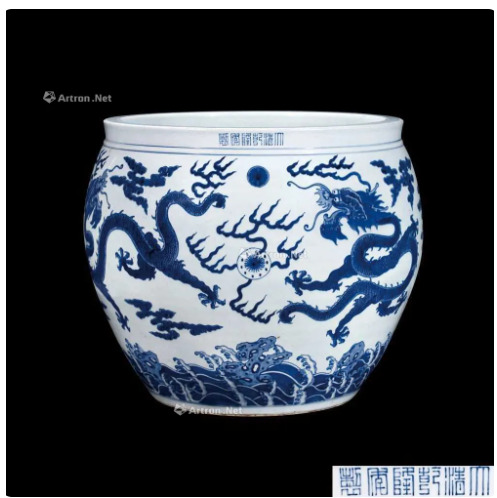
Fuxi auction| blue and white sea water cloud dragon pattern large tank
Diameter 55cm
Estimated value HKD 12,000,000-18,000,000
The transaction price was HKD 6,050,000 RMB 5,497,030
Qianlong year in Qing Dynasty
Auction lip, belly, shin, flat bottom concave. The shape is large and dignified, and the repair tire is elegant and regular. The outer wall blue and white painted cloud dragon pattern, see the sea water below the river cliff, choppy. Four dragons or struggle to chase each other, or look back at each other, the form is fierce, strong and powerful. Blue and white hair color thick and steady, painting in one go, quite royal momentum.
Beijing Palace Museum Kun Ning Palace God kitchen built-in such blue and white cloud dragon vase, the shape and decoration are the same as the lot, you can refer to here. In addition, there are also descriptions of such varieties in Yongzheng's "Tao Ye Tu". From the above data, it can be seen that this kind of cloud dragon vase was highly valued by the emperor and its status was respected. It is rare and extremely rare to exist. The Palace of Earthly Tranquility, located in the Inner Court of the Forbidden City, was the residence of the queens of the Ming and Qing dynasties.
1 note
·
View note
Text
Abridged History of Qing Dynasty Han Women’s Fashion (part 5: Late Qianlong & Jiaqing eras)

(artwork from 1782)
Previous posts:
Late Ming & Shunzhi era
Kangxi era
Late Kangxi & Yongzheng eras
Qianlong era
The last two decades of the Qianlong era, the 1780s and 90s, formed one aesthetic continuity with the reign of Qianlong’s successor Jiaqing (1796-1820). This period was characterized by a turn to extreme formal simplicity and what I believe to be a revival of the tastes of the Ming-Qing transition.
We see sleeves of women’s robes, tight fitting and short to create a practical look in the previous era, become wider and longer. The folded cuff design was retained, though now more difficult to manage as the sleeves became wider. In the last post I discussed how the construction of dajin similar to Manchu men’s fashion became en vogue among Han women and replaced the earlier center front closing robes----this remained the same. We see some of the first instances of binding strips being used around the collar and the dajin, which would become a highly popular and elaborate craft later in the 19th century. Around this time, the binding strips used were usually thin and minimal, commonly of a black color. Plain cloth or bead tip buttons were popularized earlier in the Qianlong era, and metal clasp buttons (zimukou) became increasingly rare. The shape of the standing collar remained the same as that of previous centuries, soft, unstiffened and tall.
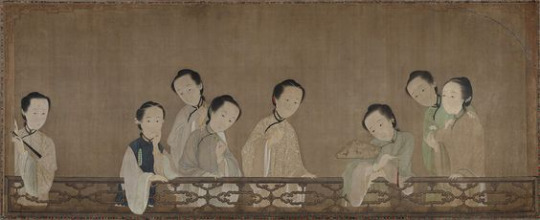
Artwork from 1796 showing a group of courtesans. You can see the black binding on some of their robes. A note about the dating of this artwork: while it’s quite a common reference image for Jiaqing era fashion, I wasn’t able to find an exact date until I read about it in the book Pictures for Pleasure and Use by James Cahill (spectacular book discussing the importance of vernacular and commercial art, highly recommend) and he said the date of creation was signed in the cyclical calendar and corresponds to either 1736 or 1796. He was inclined to 1736 because of “similar face shapes” or something to Yongzheng era artworks, but since he wasn’t a fashion historian he probably wasn’t aware that the fashions depicted here would not have been possible before the 1780s, so I think 1796 is instead the correct date.
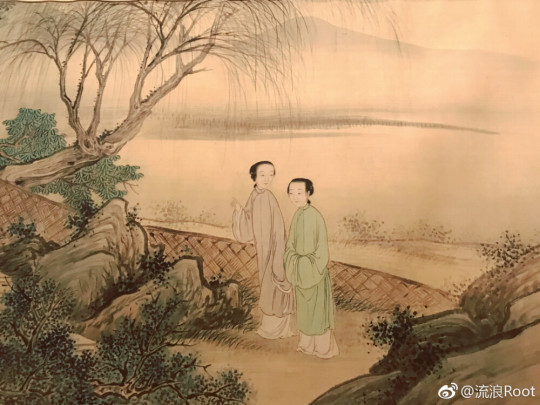
Late Qianlong/early Jiaqing era artwork, showing two austerely (and fashionably) dressed women.
The more radical departure from the previous era, however, was the complete eradication of ornament. Robes and skirts of this era were often entirely plain, with no brocaded patterns or embroidery of any kind. Gone were the roundel patterns, quatrefoil motifs on collar facings and decorative strips around skirts----only solid color blocks remained. Pastel colors like light pink, blue and green were among the most popular for robes besides bright blue and red, whereas skirts were white or black.
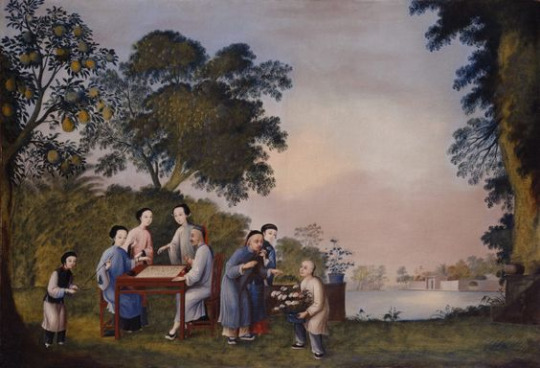
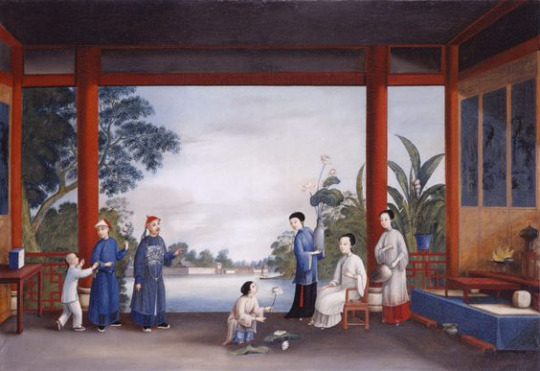
Late Qianlong/early Jiaqing era paintings of the Anglo-Chinese school showing the new style of plain garments.

Artwork from the era showing a woman in a light mustard robe with dusty pink cuffs, white skirt and red sash (sashes were still commonly worn).
The other significant changes happened in hairstyling. The 1780s did away with the iconic tall knots of the earlier Qianlong era, instead moving the mass and volume of hair toward the back. We see the re-emergence of the swallow tail. The front of the hair could be middle parted or completely pulled back. Flowers and other ornaments could be worn on the sides of the hairdo, behind the ears. The general shape of hairstyles stressed horizontality rather than verticality, as was the case before.
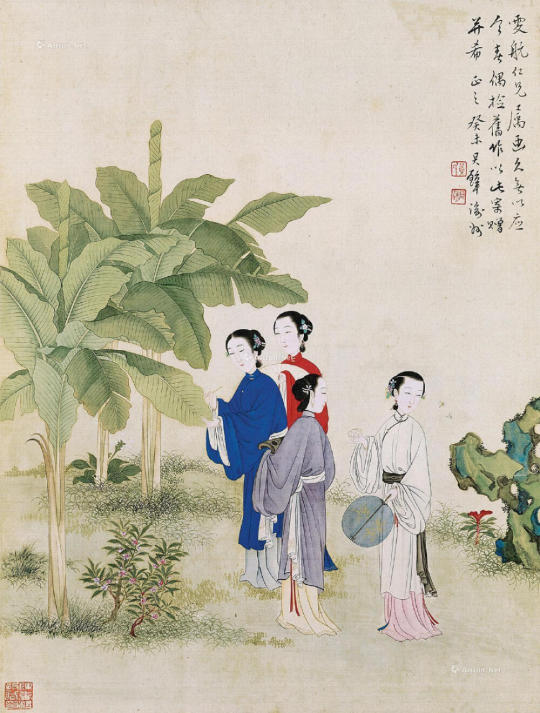
A 1943 copy of a turn of the 19th century original, showing the front and back of hairstyles.

Bust portrait showing the new hairstyle.
A unique hair accessory of the 1780s and 90s was a new iteration of the mo’e, which now had a sharply pointed triangular front and was worn high on the head instead of at the forehead. I think it became less common as the 19th century approached.
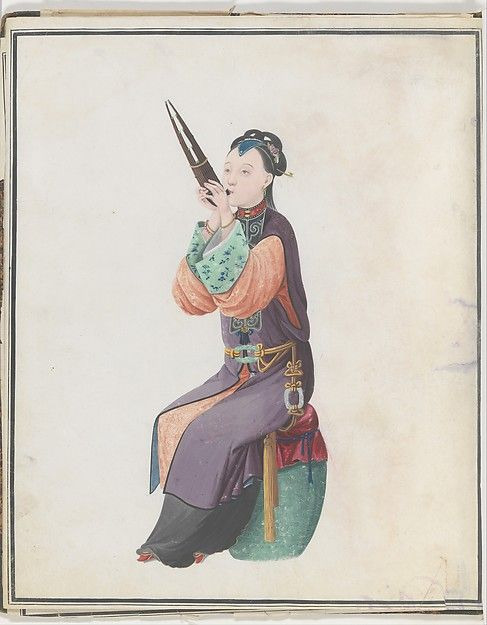
Export artwork showing a woman musician, likely 1770s or 80s as she is still wearing the ornamented, center front closing robes popular in previous decades.
Minimalism was not to last long, however, and soon decorative patterns began to reappear on robes, sleeve cuffs and skirts. Hairstyles began to gain volume and became more puffed, forming a sort of face framing crown. New styles of decorating skirts appeared, with binding going around the qunmen and the edge of each pleat, and embroidery on each individual pleat. The rectangular or circular patterned patch popular prior to the 1780s returned.
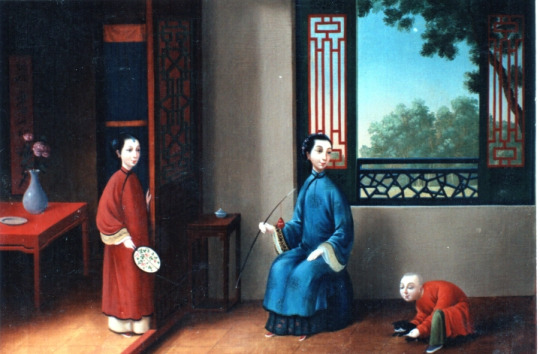
Early 19th century export painting at the Brighton Pavilion, maybe 1810s. We can see roundel patterns on the blue robe, embroidery on the cuffs and skirt, and the lady in red wears a pointed mo’e.

Presumably later Jiaqing era artwork, ca. 1810s, showing a group of women. Floral embroidery is present on the sleeve cuffs, the skirts are decorated.
#abridged history of qing dynasty han women's fashion#18th century#19th century#qianlong era#jiaqing era#qing dynasty#chinese fashion#fashion history#regency era
189 notes
·
View notes
Note
Hi! I hope you are doing okay with all the discourse going around. Im white and raised in a very white society so i will never have a say in it, but i was wondering, is there any way i can educate myself more in asian/chinese culture? Im aware i consume content thru western lens and because of that i dont really get all the nuances of the shows, but i would like to have at least some backround. Im guessing just watching the shows doesnt give enough of that, can you maybe reccommend some blogs or books to check out? (If you dont thats totally fine and im sorry if i said anything offensive)
Hey friend! Not offensive at all, no worries. Honestly, I’m not too sure. I think just keeping an open mind about things is a really good start. I’m not really sure which blogs to recommend but if I could recommend some dramas? Since it’s probably easier to watch a show then read a book?
《The Story of Minglan》 is a good one to sort of parse out the intricacy of historical Chinese society in the Song Dynasty, keeping in mind that different dynasties have different practices, so even amongst different time periods there were differences. 《The Story of Yanxi Palace》 is another good one for Qing Dynasty (circa 1740s) if you wanna get into imperial harem stuff. (Or you can watch 《甄嬛传》 or 《如懿传》 for harem stuff. I just think The Story of Yanxi Palace is the most palatable, most aesthetic, and most fun out of the three. The other two are kinda tragic?) There are other dramas but I feel they’re not as... accessible?
Chinese historical dramas come in 3 flavours: serious dramas, idol dramas, and those that ride the fence. What I mean by idol drama is...everyone in it is young and hot and the writing is eh and the acting is eh. More often then not there’s a lot of modern elements to it. The Untamed is so popular because it’s idol drama done really well. (xianxia and wuxia genre used to be more quality when I was a kid, but now they’re kind of ehhhh.) I would say Minglan and Yanxi are both successful because they ride the fence.
On the other hand, serious historical drama has A LOT of politics and can be quite dry especially if you’re watching it through half-assed subtitles. The actors typically are more seasoned, older. People jokingly say that idol drama is what mom watches and serious drama is what dad watches, and honestly given my parents’ tv habits...it’s pretty accurate 😂.
Some really well known ones from the past 20 years are:
The 《铁齿铜牙纪晓岚》 series 1-4. I would only recommend part 1-2, 3-4 are not as great. This one has quite a bit of humour but it might fly over your head a bit because of the language barrier. The story surrounds a well known government official and scholar named Ji Xiaolan 纪晓岚, his frenemy and colleague the (EXTREMELY corrupt) prime minister He Shen, and the Emperor Qianlong. For better or worse these three are depicted as both liege and subjects as well as friends. Trying to see Ji Xiaolan and He Shen one up each other while Qianlong tries to balance his court and rule the country is quite interesting. I won’t pretend this is an easy series to follow, but it’s actually quite fun.
《汉武大帝》 - is about Hanwu Emperor of the Han Dynasty circa 150 BC? He’s one of the most famous emperors of distant history. It’s basically about the course of his life and the many people that featured in it.
《大明王朝 》- my memories of this one is very vague, but it is about the Ming Dynasty (the dynasty before the Qing Dynasty c. 1500,1600.)
《The Advisors Alliance 军事联盟》- 2017 two-part television series based on the life of Sima Yi, a government official and military general who lived in the late Eastern Han dynasty and Three Kingdoms period of China. circa 150 AD.
As a side note, a lot of serious dramas for a while now have been focused on the Qing Dynasty, just because it’s the last imperial dynasty before Imperial China fell into decline, WWI and WWII ravaged the country and communism happened. Even a lot of idol drama are about the Qing Dynasty (I feel like I should do a post about this, just to string things together haha).
So for the Qing Dynasty, because they are Manchurian, their last name is Aisin Gioro or in Chinese Aixin Jueluo 爱新觉罗. Their earlier emperors are much more well known than their later ones and have been the focus of MANY dramas. (You’ll notice their names in the beginning spell very different than the Chinese names you’re used to, but once they take over China, the emperors’ names start to become more and more mainland Chinese and less and less Manchurian.)
Nu’er Hachi 努尔哈赤/ Nurhaci - The granddaddy of Qing Dynasty, but was never officially Emperor of China during his life time.
Huang Taiji 皇太极 - Nurhaci’s oldest son. He led the campaign against the Ming Dynasty but died before the campaign was over
Fulin 福林, Emperor Shunzhi 顺治 - Huang Taiji’s 9th son. He is the real first Emperor of the Qing Dynasty. His uncle Duo’Ergun 多尔衮/ Dorgon was his regent as well as his commander-in-chief. Dorgon was the one who won the war against the Ming Dynasty and instated his nephew as the Emperor. Fulin was 6 years old when this happened, and now you may wonder why the fuck is that? It’s because Fulin’s mother, Huang Taijii’s widowed concubine Consort Zhuang (name: pu’erji-jite bumubutai (pinyin) 博爾濟吉特 布木布泰/ Bumbutai Borjigit, Da-Yu’er 大玉儿) remarried her brother-in-law Dorgon. Whether Bumbutai and Dorgon were actually in love is....contestable. Certainly one of my favourite serious dramas that depict this part of history is《大青风云》.
Xuanye 玄燁, Emperor Kangxi 康熙 - Fulin’s third son. Very famous. Very long reign. Serious drama associated 《康熙微服私访记》, 《康熙王朝》
Yinzhen 胤禛, Emperor Yongzheng 雍正 - Xuanye's 4th son. His reign was highly contested because some ppl believed he forged the succession document. It’s probably not true. He was an efficient emperor but very austere, very severe. Not well liked. The best serious drama about him is probably 《雍正王朝》and the aforementioned《甄嬛传》. The former is 100% politics and a fictional re-telling of historical events whereas the latter is 100% harem drama and 100% made up. 《步步惊心》is an idol drama about a girl who transmigrated back to this time and fell in love with Yinzhen. Lol.
Hongli 弘历, Emperor Qianlong 乾隆 - Yinzhen’s 4th son. I think he’s the longest living/reigning emperor of Chinese history. SOOOOO many dramas were made about him or set in his reign. Of the serious drama category: 《铁齿铜牙纪晓岚》 that I mentioned earlier is really good. There are others but I won’t name them here. 《如懿传》 is a serious drama about his harem, but really terrible? I really didn’t like it (just my personal view). Incidentally it was released around the same time as《The Story of Yanxi Palace 延禧攻略》which is also about his harem and MUCH better in my opinion, because the actor for Hongli in Yanxi is much better skills-wise. 《还珠格格》was the OG idol drama about Hongli’s children. I gave a brief synopsis about it here. It was made in the 90s but damn...so nostalgic.
There’s many more emperors after him, but they’re not as important.
Okay yeah, so I’m not sure if any of this is really helpful, but definitely watching serious drama gives you much better context and understanding of Chinese culture than idol drama. I mean when the drama has flying and magic...the historical relevance sort of falls to the side. 🤣
ADDENDUM: I made a typo earlier. Fulin is Huang Taiji’s 9th son, not Nurhaci’s son. Also Abahai is Huang Taijii’s mother’s name (wikipedia lied to me on this one XD).
128 notes
·
View notes
Text
Painting-Portrait ART
China
During the Reign of Emperor Kangxi, missionaries such as Lang Shi-ning, Pan Ting-zhang and Ai Ming-hui offered paintings to the imperial court, thus bringing western oil painting techniques to the imperial palace. During the reign of Emperor Yongzheng and Emperor Qianlong, the bao-yi (manchu for servant) of the imperial court was ordered by the emperor to learn oil painting from missionaries, but left little trace. In the Qing Dynasty, The 13th Bank of Guangzhou became the only trading port in China, and "export painting" was one of the export products. Foreign painters also came here to make a living, and received their students, cultivating the first batch of Chinese oil painters, such as Shi Bellin, Guan Qiaochang and Lian Chang. Shi Bellin was "the earliest oil painter in China". After the 1830s, The British painter George Chenally came to China to teach gouache painting techniques, greatly improving the level of Guangzhou "export painting", Guan Qiaochang is his master, Guan Qiaochang's "Head of the old man" was selected to the British Royal Academy of Art exhibition, is the first Chinese painter in the European exhibition. [2] [3]
After the Reform movement of 1898 in the late Qing Dynasty, many young students went to Britain, France, Japan and other countries to learn Western oil painting. Among them are: Li Tiefu, Feng Ganbai, Li Yishi, Li Shutong (Master Hongyi), Lin Fengmian, Xu Beihong, Liu Haisu, Yan Wenliang, Pan Yuliang, Pang Xunqin, Chang Shuhong, Wu Dayu, Tang Yihe, Chen Baoyi, Guan Liang, Wang Yuezhi, Wei Tianlin, Xu Xingzhi, Ni Yide, Ding Yanyong, etc. After returning to China, these people brought advanced teaching methods and concepts from the West and Japan. For example, Li Tiefu was the first Chinese to master the pure oil painting technology and was known as the "Father of Chinese oil painting" [4]. Zhou Xiang founded China's first art school when he returned from the West in 1911. In 1912, Liu Haisu founded the Shanghai Academy of Painting, and for the first time began to draw with human models; In 1919, Mr. CAI Yuanpei, who served as the director of education, initiated the establishment of the first national fine arts school -- Beijing Fine Arts School (president Lin Fengmian). In 1927, the Department of Art was established in Central University (Xu Beihong was the director). In 1928, Hangzhou founded the first university system of the National Art College (Lin Fengmian as president).
The three main painting schools of this period are: realism school (Xu Beihong); New School of Painting (Lin Fengmian, Liu Haisu); Modernism (Pang Xunqin).https://painting-portrait.com/
In this period, China was torn by war. Without stable social environment, oil painters were displaced from place to place. Many oil paintings used paintings as weapons to reflect the war and expose tyranny, such as Wang Shiguo's "Taierzhuang Bloody Battle", Tang Yihe's "Victory and Peace", Situqiao's "Lay Down your Whip" and so on. Because of the war, some painters went to northwest and southwest China and other ethnic minority areas, and created masterpieces such as The Woman in Negative Water (Wu Zuoren) and the Kazakh Shepherdess (Dong Xiwen).
At that time, yan 'an painters' painting style was influenced by "Speech at yan 'an Forum on Literature and Art", and tended to serve "workers, peasants and soldiers". Xu Beihong's realism was in harmony with The Times and gradually formed the standard oil painting in China.https://painting-portrait.com/
Under the influence of the view that "new art must be combined with the people", realism dominated the world, while landscape, still life, figures and other subjects were neglected. During this period, a number of revolutionary historical paintings were produced, such as Hu Yichuan's "Opening Shackles", Wang Shiguo's "Joining the Army", Luo Gongliu's "Tunnel Warfare", Dong Xiwen's "Founding Ceremony", Li Zongjin's "Seizing Luding Bridge" and Ai Zhongxin's "Crossing Snow Mountains". With the development of the mass movement, Chinese oil painting entered the situation of "overall sovietization", and the oil painting teaching with Pavel Petrovich Cheschakov teaching system as the core quickly became the single teaching system of Chinese oil painting, and cultivated a number of oil painting backbone. Later, a group of oil painters made a breakthrough in the single oil painting system in the expansion of the spirit of "nationalization", forming luo Gongliu's "On Jinggang Mountain", Li Huaji's "Princess Wencheng", Yuan Yunsheng's "Water Town", Xu Jianbai's "Memories before the Old House" and other works.
In 1964, under the slogan of "class struggle is the key to everything", Lin Biao, Jiang Qing and others carried out a cultural sweep against the literary and art circles. Many painters' works were washed and looted. Zhong Han's Beside the Yan River, Du Jian's Marching in the Torrent, Li Huaji's Princess Wencheng and Qin Zheng's Home were all exposed to public criticism on false charges and destroyed completely.https://painting-portrait.com/
On the other hand, oil painting became a tool to create gods. Chairman MAO went to The Source of Peace became a typical work of the time, with a print volume of more than 100 million copies at that time. At this time, some young oil painters began to emerge, such as Chen Danqing, Shen Jiawei, Chen Yiming and so on. Representative works include: "Never Truce", "Ode to the Yellow River", "Tears shed in the Harvest Field", "I Stand Guard for the Great Motherland" and so on.
After the Cultural Revolution, there was an opening period of literature and art, in which various forms of painting flourished and diversified. Among them, Luo Zhongli's Father, Chen Danqing's Tibetan Paintings, Wen Lipeng's Daughter of the Earth, and Zhan Jianjun's Looking Back are all masterpieces of this period. After the initial period of art gushing, oil painting has come to a new crossroad, and The Chinese painting world urgently needs more modern and fresher air. Among them, 胡悌麟, Jia Difei's "General Yang Jingyu", Su Xiaobo's "Aunt's House", Yu Xiaofu's "I gently Knock on the door", Yu Yunfei's "A corner of the Park" and other works, under the attention of contemporary consciousness of thematic painting for a new development.https://painting-portrait.com/
However, although the shackles of culture have been lifted, due to various reasons (mainly economic reasons), the vision and thinking of most painters have not been fully opened to appreciate the various and complex changes in the world today, so there is a lack of truly representative works. After all, Chinese oil painting has entered a new era, which is learning, transforming and constantly enriching.
古典
The classical
The development of oil painting has experienced several periods of classical, modern and modern times. Oil painting in different periods is controlled by the artistic thoughts and techniques of The Times, presenting different features.https://painting-portrait.com/
The historical conditions in the early stage of oil painting established the realistic tendency of classical oil painting. 15th century European Renaissance, humanism critique of religion, with a focus on the reality of the society, actively seek many famous painter to gradually get rid of a single Christian classic for the creation of the subject matter, characters, scenery, items from the start to life at that time to observe and describe directly, make the works of religious subjects with obvious secular reality factors, Some painters depict real life scenes entirely. Renaissance painters inherited the Greek and Roman artistic concepts, that is, not only pay attention to the work to describe a certain event or fact, but also reveal the cause and effect of the event or fact, so the formation of a focus on the conception of typical plots and typical image of the art. At the same time, the painter also explored the application of anatomy, perspective in painting, and the role of the distribution of light and shade, forming the scientific principle of modeling. The application of human anatomy makes the figures in the painting have the accurate proportion, shape and structure relationship as real. The establishment of focal perspective makes the painting form the depth space of illusion through composition, and the scenery in the painting is the same as the directional instant visual experience in reality. The method of shading makes the objects in the painting unified under the light from a main light source, forming a clear hierarchy from near to far. The artistic theme of humanism and the modeling concept of pursuing realism can not be perfected in other paintings because of the limitation of tools and materials, and the properties of oil painting tools and materials are just suitable to fully reflect the two. As a result, classical oil painting has become a highly realistic look that has been produced for a long time.https://painting-portrait.com/
Some oil paintings in the 17th century emphasized the sense of light in oil painting, and created the sense of light by using the contrast of cold and warm colors, the contrast of light and shade intensity, and the contrast of thickness and layer, forming a dramatic atmosphere in the picture. Italian painter Caravaggio broke the orderly and harmonious light effect in his previous oil paintings. He intensified the contrast of light and shade on the picture, and often used the large dark part of the background plane to set off the bright figures in the foreground, making people feel the dazzling light in the painting. Spanish painter el. El greco scene processing into under the dappled light shadow, he is not from the light and shade two decent, but from the discontinuous scattered on modelling, the distribution of light and shade of color changes in temperature and forming of continuous change, dignified pen, color bleeding from each other in the extrusion, the uncertain effect of pictures to the person, some even filled with mystery and anxious mood. Rembrandt, a Dutch painter, also took the sense of light in his paintings as a means to express people's mental state. In a large number of portraits he made, the figures were covered by large dark parts, and only the important parts such as face and hands showing expressions showed bright brightness. He used calm colors to paint the dark part in multiple layers to make the dark part appear deep, and used thick paint and painting knife stack color method to paint the light part to create a thick sense of volume. At the same time, the use of brushwork was also explored by many painters.
1 note
·
View note
Note
hey! do you mind explaining the whole lucky 4/ lucky 8 convo that take place in ep 63 of ruyi? like what was the meaning behind it?
bear with me anon because this post is gonna be another long one
the conversation is really prompted when yanwan, in an attempt to insult yongcheng, brings up the eight and ninth princes of the kangxi emperor, qianlong’s grandfather, who were punished for their involvement in the succession war that took place between the various princes of kangxi for the seat of the crown prince. they were punished by being forced to change their names to acina and seshe which were manchu words that meant “to carry your crime” and “annoying person” respectively but when translated to mandarin it meant “pig” and “dog”, which was used to condemn their sins.
yuyan is angered and questions yanwan if she was comparing her sons to the eighth and ninth princes of the kangxi emperor. ruyi then says that yuyan is taking it too personally and that qianlong would never have such unfilial sons. it is then that yuyan responds that of course her children wouldn’t be that way and that they are lucky due to them being the 4th and 8th princes, as the founding emperor of the qing dynasty hong taiji, qianlong’s great-great-grandfather, was the eighth son of nurhaci, the khan of the jin dynasty, and the yongzheng emperor (qianlong’s father) was the fourth prince and so qianlong is the 4th prince too. she ends of by saying that no matter how unskilled her sons are they at least have the luck of their ancestors.
since yuyan brought up the correlation between the numbers to the succession, which is a taboo topic due to the conflict that happened during the kangxi era, everyone in the harem is just going uh-oh and that is eventually what triggers qianlong to have her permanently demoted. there might be some innaccuracies here but that is about it.
12 notes
·
View notes
Note
I've just started getting into period c-dramas and I see you reblogging about a few of them. And I was wondering if you had some recs? Thanks, I love SM and DH. it's okay if you don't answers this I know this may not be the purpose of your blog.
Hi nonny!
Period cdramas are my jam!!! I love period cdramas (and fantasy/wuxia/xianxia), although I used to watch primarily HK ones and only in recent years started to watch mainland ones. I’m going to assume you’ve watched The Untamed (陈情令) since you came to me and my blog is like...90% CQL lol, so I’ll leave that off this list XD
I’ll be providing YouTube links where I can, but please note that the subs on YouTube are not...the greatest. I don’t usually watch cdramas with subs, so I’m not sure which places to recommend. Sorry in advance!
Nirvana In Fire (琅琊榜)
I think everyone recs this at some point, but it’s just THAT GOOD. It’s set around the Northern and Southern Dynasties era and is primarily a political drama, but also has elements of wuxia (martial arts) mixed in. My favourite part of this drama was the intricate plot and also the wealth of interesting side characters that give the whole drama extra depth. There’s not much romance, but the individual characters and the plot is gripping enough without it.
(I tried to watch the sequel Nirvana in Fire II: The Wind Blows in Changlin (琅琊榜之风起长林), but I never really got into it? I should really try again, but at that point I was still really attached to the first one and wasn’t ready to let go lol. I’ve heard it’s good too!)
Legend of Ruyi (如懿传)
Okay I just finished watching this the other day and I really enjoyed it. It’s set in the Qing dynasty, during the rule of the Qianlong Emperor, and is about the life of Ulanara the Step Empress. I loved the strong female friendships in this (it’s rare in a Palace drama), and the complex dynamics between concubines of different ranks. The progression of Ruyi and Qianlong’s relationship feels very organic and (if you’re familiar with the history) is like a reverse-slowburn where you’re just really rooting for her to get out and when she finally stands up for herself it’s like \o/
(also cameo by everyone’s favourite shijie, Xuan Lu!)
The Story of Yanxi Palace ( 延禧攻略)
This is also set in the reign of the Qianlong Emperor, but the story is completely different. It’s about the Imperial Noble Consort Weigiya and her rise from a palace maid to the Emperor’s favourite consort. It’s funnier and more light-hearted than Ruyi, but it still has its fair share of dramas. The main character is a ‘non-traditional’ woman in that she’s outspoken, brazen and can be quite cruel when dealing with her opponents, but she’s still fundamentally a good person so you really root for her throughout the show.
I personally wouldn’t recommend watching this and Ruyi together or back-to-back because you’ll probably get whiplash from how different the characters are portrayed and how differently the history is interpreted, but it really highlights how much we don’t know about the palace women throughout Chinese history.
The Story of Ming Lan (知否知否应是绿肥红瘦)
NOT a palace drama this time! But it still explores the very complex family dynamics in China between wives and concubines and their respective children, about marriage and social hierarchy and how an unfavoured, illegitimate daughter of a low-ranking imperial official rises to become the wife of a powerful Marquis in the Song Dynasty. I’m a massive fan of Zhao Liying, the main actress, and her husband on the show is her husband IRL and they are the CUTEST HECKING COUPLE I swear to god. Their chemistry is OFF THE CHARTS.
Three Lives, Three Worlds, Ten Miles of Peach Blossoms (三生三世十里桃花)
Xianxia (fantasy/martial arts) drama about an immortal Fox Spirit and her love story with the Crown Prince of the Nine Heavens that spans over three “lives”. There’s magic, sword fighting, questionable CGI and a lot of typical romance drama stuff like pining, misunderstandings, miscommunication and jealousy etc. I found this drama more compelling than its sequel Three Lives, Three Worlds, The Pillow Book (三生三世枕上书) because the characters were better fleshed out (although a lot of the same characters appear in both), and it was easier to get emotionally invested in them. Also I find Bai Qian a lot less...annoying than Fengjiu (who is so cute, but oh my god can be quite irritating sometimes).
Love and Destiny (三生三世宸汐缘)
Apparently this is meant to be set in a similar universe to Peach Blossoms, but it’s quite different. This is the love story between a young bird spirit and the God of War, which also spans over three lives. I found it a lot darker than Peach Blossoms, and a lot more tragic, but I enjoyed it a lot more than I had expected to when I first heard about it. I really liked the main character (Lingxi) here (she’s a good mix of Bai Qian and Fengjiu), and although I wasn’t quite sold on the development of her relationship with Jiu Chen at first, they won me over with some really heart-wrenching story lines.
(I don’t know if the playlist above is Eng subbed though, sorry!)
Other dramas that I liked are:
Empresses in the Palace (甄嬛传) - it got really messy in the end, but I really like Li Sun so I kept watching. It’s meant to be a prequel to Legend of Ruyi (above), set in the reign of the Yongzheng Emperor (Qianlong Emperor’s father). Don’t watch it on Netflix though, they really messed it up by trying to condense the story and it doesn’t work.
Legend of Fuyao (扶摇) - xianxia drama about a slave girl who was cursed as a child and sets off to collect magical artifacts to lift it. I got up to about Episode 20 and then life got in the way, so I didn’t finish it, but I’ve been meaning to get back to it one of these days. It stars Yang Mi, who plays Bai Qian in Peach Blossoms.
Princess Agents (特工皇妃楚乔传) - I really liked this drama, but it gets really dark and touches on some darker themes like rape, murder and torture, and the story gets quite messy and it ends on a cliffhanger (there was talk of a sequel a couple of years ago, but nothing’s come of it). Stars Zhao Liying (from Story of Ming Lan), who is so badass in action roles.
Noble Aspirations: The Legend of Chusen (青云志) - another xianxia drama about an orphan boy Zhang Xiaofan who joins the Qingyun Sect after the massacre of his village and falls in love with the daughter of the leader of the Ghost King (an enemy of the “righteous” sects). It starts off quite slow, took me about 5 eps to really get into it, but I enjoyed it for the most part. There’s a season 2 that kind of ends on a cliffhanger, and there’s been rumours of season 3 for years but nothing has ever come of it so it was quite disappointing. Stars Zhao Liying (again, I’m a massive fan haha), and is based on the same novel as Xiao Zhan’s movie Jade Dynasty (which I haven’t watched yet).
#besanii watches cdrama#drama rec#obviously I don't stray much from my preferred genres#but here you are#hey nonny nonny#asks
98 notes
·
View notes
Text
Empress Dowager Cixi was a devotee of Buddhism
As well as a worshiper of Manchu’s shamanism.
Here’s a story about gold and the sun
At the end of Yuan Dynasty and early in Ming Dynasty
The Yehe Nara Clan, which established the Yehe Kingdom, clashed with
The Aisin Gioro Clan in a war
In order to make the Yehe Nara Clan give in, the leader of the Aisin Gioro Clan
Pointed at the land and said:
“We are the most sacred gold on this land.”
Aisin Gioro means gold in Manchu language
The leader of the Yehe Nara Clan could only laughed
He pointed at the sun above:
“How can gold be great?
Our name is after it!”
The Yehe Nara Clan was eliminated by the Aisin Gioro
In early days of Qing Dynasty
Before its official establishment as a country
A small clan called Yehe Nara living near the Aisin Gioro
Which then eliminated the small clan
Before the chieftain of the small clan died, he vowed to the heaven:
"We shall take our vengeance
Even only one of our women lives!"
Such a story was recorded in the law of the Qing’s royal court
No one from the Yehe Nara shall be allowed to enter the royal court
The regulation was observed for more than two hundred years
See, it’s been through Kangxi, 60 years, Yongzheng, 13 years
And Qialong, 60 years
After Qianlong, there was another 200 years of Jiaqing, Daoguangm, and Xianfeng
Nothing went wrong
They were relaxed
Cixi was from the Yehe Nara
When she entered the court
Emperor Xianfeng knew about her origin
But
He thought that nothing went wrong during these 200 years. It would be okay
He accepted her
And eventually Qing was destroyed in her hands
Their chieftain
Held a resolute heart for revenge
He’d been waiting for over 200 years
Waiting for their fortune depleting
And then he came
To destroy them
Scientific knowledge was a necessity in the royal court
But the system was got rid off by Cixi
After she had the power
She abolished it
No scholars were hired to the court
Not anymore
What did she like?
She preferred Fuji (spirit writing)
Just Fuji
For great matters of the country
She didn’t ask for the scholars or experts
She asked for the spirits
The ghosts and the gods(also ghosts)
And then the country was no more
This truth
Was told by Master Zhangjia
For one time, about Fuji
I had a question (Master Chin Kung)
And asked him
He then told me of this history
Cixi abolished the academy
And set the altar for Fuji in the court
The altar was the harbinger of the country’s fall
Our ancestor said
The country should listen to the people
If it is to be made a prosperous one
Listen to the civics
The country will fall
If hearing the words from the ghosts and the gods
Their words
Lead to the destruction of the country
So we must understand the truth
A truth that was proved by a maiden at the end of a dynasty
At the year of Boxer Rebellion
The maidens and the empress participated in a public ritual celebration in the Palace of Earthly Tranquility
After the period of Yongzheng
The Palace became a ritual site for the Qing royal family
I’m going to introduce the Pole Ceremony
The pole used here is similar to the telephone pole we now have
The fujins (maidens) accompanying the empress were all listening in owe
They were sitting beneath the main shrine
On the mattresses made of wolf hides
In terms of feng shui, the primary seat was on the west in Manchu custom
Which was different from the Han custom, in which the primary seat was on the east
So they put their ancestral tablets on the center and north-west corner of the main shrine
When the ritual started
There were also drummers
Dancing and circling around the pole
Soon after
There would be some devils in grotesque forms coming out
Crying, jumping, and breathing fire
And then two of the Shaman gods
The devils delightfully followed the Shaman
And then bowed and kneeled before the old empress, wishing her long life for three times
After the ritual, pigs would be slaughtered as the gift in the palace
And everyone would have the pork as a meal. [Translated by 華碩翻譯社]
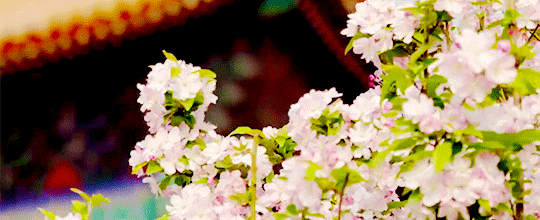
0 notes
Text
20/12/2017‘History of the World in 1,000 Objects’
The book ‘History of the World in 1000 Objects’, published by DK Publishing, provides an overview of arts and culture during the Qing Dynasty, and even elaborates upon the very object I have chosen.
The Qing Dynasty: China’s Age of Prosperity
The Qing dynasty lasted from 1644 until the start of the 20th century, and was founded by the Manchus from Manchuria. The Qing dynasty was marked by strong leadership, beginning from Kangxi, China’s longest serving emperor. Under his reign, the size and population of Qing China grew, as Kanxi consolidated control and quelled internal revolts. Qing society was guided by Confucian philosophy and many followed the principles of Taoism. Kangxi opened up several ports for trade with foreigners, which added to the prosperity of this period, which continued under the reigns of Kangxi’s son (Yongzheng) and grandson (Qianlong). Both Yongzheng and Qianlong were great patrons of the arts, which allowed for the arts and culture of the period to flourish.
The Jade Boulder
Context of object: This nephrite boulder dates from the Qing Dynasty, during the reign of emperor Qianlong (1735-96), who was an enthusastic collector of elaborate engraved objects. This period is conidered to be on eo fhte high points of jade output, partly driven by the emperor’s love for the stone.
Significances of Jade: Jade has long been a symbol of power and wealth, but also developed moral dimensions. Confucius (551-479 BCE), likened the virtues of honourable people to jade, describing the stone as “fine, compact and strong - like intelligence”.
The spiritual dimensions of jade are thought to include healing powers, and to bring people closer to the deities of Taoism and Buddhism. The finding of carved jade objects in ancient tombs of nobles suggest a ritualistic and religious usage in the past. Later, pieces include deities, symbolic animals, and images related to folk tales and myths.
Analysing jade boulder:
Steps up the mountain: represent spiritual journey undertaken by pilgrims and other devoted followers
The rounded shape: may have been achieved using techniques like sanding.
Colour: Nephrite could vary dramatically in colour; here the shades include cream, green, yellowy gold (imperfections in nephrite lead to mottled colours like yellowish gold - personally I think these imperfections add beautiful touches)
Mountainous terrain: represents belief that mountains were a realm between heaven and earth
Deer: symbols of longevity and wealth. Often depicted alongside images of gods.
Plum, pine and bamboo trees: often depicted together. Known as the “three friends of winter”; pine represents endurance in the face of adversity, plum symbolises good luck and bamboo stands for longevity
Temple: carved into the route, it depicts the journey from life to afterlife
Three gods: known as Fuxing (happiness), Luxing (status) and Shouxing (longevity). Closely associated with Taoism.
Source: DK Publishing. (2014). History of the world in 1,000 objects.
0 notes
Note
Why do you think so many dramas are obsessed with the Qianlong era?
Very very good question, thank you for asking. This turned into sort of a rant but I’ve been wanting to say these things for a long time. I don't know how well known this trope is outside China but there is the idea of 康雍乾盛世, or the "Golden Age of Kangxi-Yongzheng-Qianlong" in Chinese history discourse, which glorifies the second half of the 17th and the whole of the 18th century as this super powerful and amazing time period within the Qing. Emperor Qianlong himself has somewhat of a cult of personality and is a popular figure in historical fiction, especially the bogus and disreputable kind involving romances (野史). His status as the monarch made it easy to write dramas set in the court, which is a perfect fit for the 清宫剧 or Qing court/harem drama genre popularized in the late 1940s. Actually, thinking about it Marvelous Women is one of the only famous Qianlong era dramas that are set outside of court, that's commendable (but then its inaccuracy makes it a lamentable missed opportunity). Actually maybe there are more out there but the inaccurate costuming makes it very difficult to address them as Qianlong era. In the 2000s and early 2010s there were multiple Qing court dramas set in the 17th and 18th centuries, so they have developed into a familiar television cliche and even a cinematic universe of sorts. It’s kind of similar to how a lot of European period dramas are obsessed with Marie Antoinette? Once you make a couple dramas about the same person/group it just keeps going.
On the contrary, the 19th century is known as the "century of humiliation" in China because of Western imperialism, and the Qing court in the 19th century has always been depicted as barbaric and backward in the colonial, Orientalist narratives touted by both actual Western imperialists and Chinese nationalists who internalized their views, so most people don't feel comfortable romanticizing the 19th century court. Personally I am not burdened with this whole shame baggage because I think the Qing was not at fault for being colonized at all, it was the colonizers’ fault, if anything. We do not victim blame in this house. Also, there is plenty of photographic evidence for 19th century China, so in a way it doesn't feel distant enough to sustain a fantasy. Most dramas set in the 19th century court are so called 正剧 or "serious dramas" about political intrigues and grand nationalist undertakings, which are supposed to be more realistic (though I feel like they’re only considered serious because they have a male target audience...)
Sorry got a bit carried away here. Going back to the popularity of the Qianlong era, "Golden Age of Kangxi-Yongzheng-Qianlong" is a concept that irritates me to no end. The assignment of golden ages arbitrarily creates some periods that become overrepresented and some underappreciated, and marginalizes transitional periods where potentially important changes take place. Oftentimes when I see people’s reactions to beautiful artifacts or art from conventionally “weak” time periods, how they act all surprised and say something like “wow I did not expect such nice things to come from this time period” I can’t help but roll my eyes. Life will always be difficult for some people and enjoyable for others regardless of time period, in order to write a story the perspective has to be cherrypicked anyway, so why bother shying away from conventionally “weak” or “unstable” periods. This is not to mention how the criteria for choosing a golden age often reinforce structures of power and bigotry; “golden ages” in Chinese history were usually times when the military was strong and society was conservative, when China was invading other countries left and right and subjugating other peoples. It’s so uncomfortably male centered and overly nationalistic, and plain immature...
And as we can see in the miserable level of accuracy in dramas set in the Qianlong era (or any other popular era to be honest), this obsession is nothing more than 叶公好龙, an obsession with the idea of something and not its content. Most producers don't actually give two hot fucks about real fashion in the Qianlong era, just ways in which they can use it as a backdrop for a fantasy. Despite the wealth of dramas and other media set in the Qianlong era, I have never seen a single Han women’s costume that is actually based on real sources from the Qianlong era (though I have seen some in Song of Youth, which is... set in the Ming Dynasty).
The second half of the 18th century is a non era in Chinese fashion history, a void with next to zero recognition and a public ready to either deny its complete existence or appropriate it as the late Ming. Personal anecdote: I was once visiting the Museum of Applied Arts in Vienna with a friend and there was this wallpaper from the Qianlong era with human figures in realistic fashion on display. This friend was quite interested in historical fashion so I pointed out to her that those clothes were Qianlong era (it also said that in the description of the artwork), and she straight out fucking refused to believe that and insisted they were from the “very early Qing”. This is not at all her personal opinion but a very widespread mindset in Chinese history discourse. I guess this goes back to the misconception of “late Ming fashion continuing into the early Qing” and all Qing fashion that do not look like stereotypical 19th century clothing getting mislabelled as Ming instead. It is incredibly frustrating. This is what I mean when I say 18th century erasure. It is so normalized in the Chinese period costuming industry that it doesn’t even sound weird or wrong to a lot of people, even though it should.
I know many readers of my blog are interested in Western historical fashion as well, so to illustrate how absolutely bonkers 18th century erasure is let me make up some examples. Imagine, there is this new drama set in Georgian Britain, and they use exclusively costumes like this:
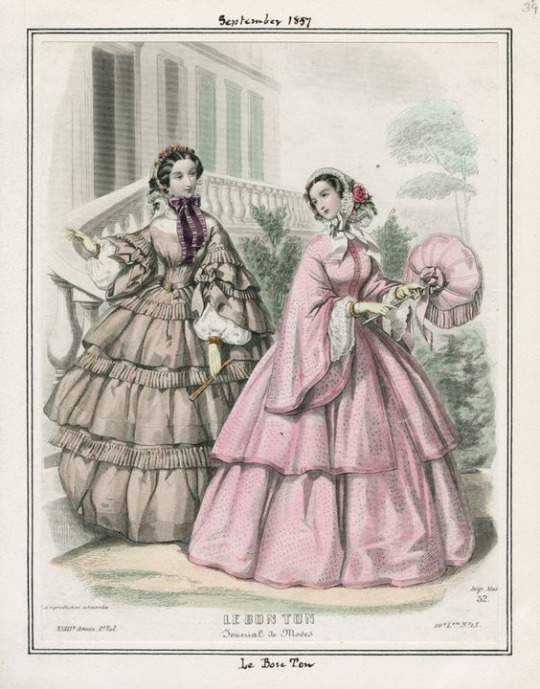
Source
Or like this:
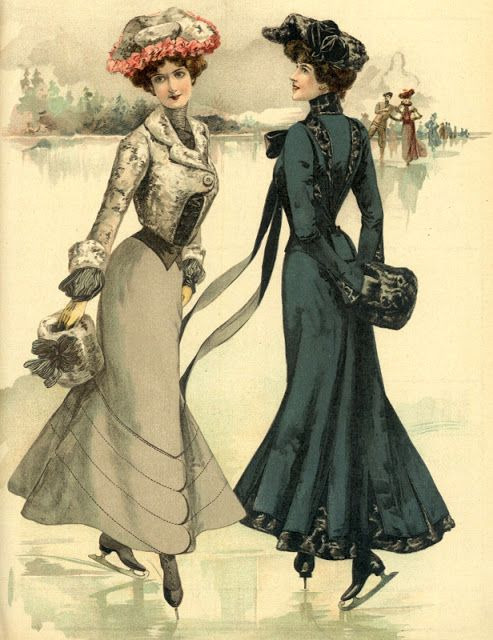
Source
Or even like this!!!
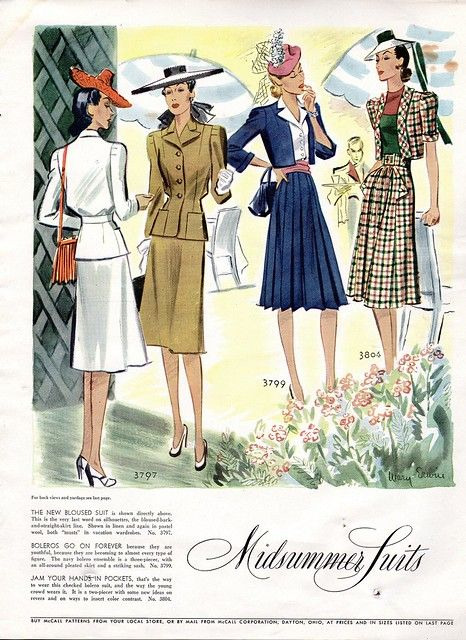
Source
(A lot of Manchu fashion featured in period dramas are legit from the 1940s)
And then you show someone an 18th century fashion plate you found
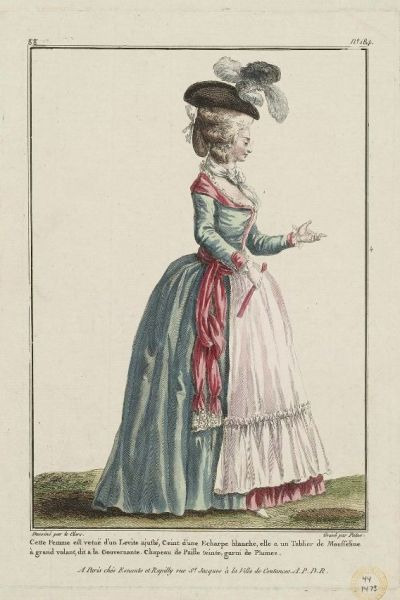
Source
and they say, “oh this looks kind of Tudor, it must be 17th century! In the 18th century people actually wore what is shown in the drama, which is very accurate.” Wouldn’t you want to metaphorically yeet yourself out of the window?? How is this widespread and acceptable??
#qing dynasty#qianlong era#orientalism can eat shit#18th century#18th century erasure#yes this is a new tag now
345 notes
·
View notes
Note
Hello ! I hope I'm sending this ask to the right place ! 🤓
I was wondering how the naming system worked in the Qing Dynasty. It seems that each Emperor decides to give a certain particle to his sons and that it changes with each ruler. Emperor Yongzheng seems to have chosen the particle "Hong" for his sons (Hongli, Hongzhou, Hongyan) while Emperor Qianlong seems to have chosen the particle "Yong" (Yongqi, Yongyan, Yongcheng, Yongzhang), Emperor Jiaqing the particle "Mi" (Miankai, Mianxin, Mianyu) and Emperor Duaogang the particle "Yi" (Yizhu, Yigang, Yiji).
Is there any kind of tradition to this, and if yes, how does it works ? 🤗 I have to say I'm quite intrigued by this system since it changes quite much from the traditional Charles, Henrys and Louis we know. Also, pardon me if the term "particle" isn't the right word but I didn't really know how to call it !
The name that all of the emperor's sons share is called a generation name. You can read more about it here.
We also have a couple of posts about it here and here.
12 notes
·
View notes
Text
Giuseppe Castiglione, S.J. (郎世宁; Lángshìníng) (19 July 1688 – 17 July 1766), was an Italian Jesuit missionary and an artist at the imperial court of three emperors – the Kangxi, Yongzheng and Qianlong emperors.
He painted in a style that is a fusion of European and Chinese traditions.
Giuseppe Castiglione was born in the parish of San Marcellino in Milan; his baptismal certificate is kept in the diocesan historical archive. On Jan. 16, 1707 he became a Jesuit, entering the novitiate of Genoa.
Empress Xiaoxianchun (28 March 1712 – 8 April 1748) was the first Empress Consort of the Qianlong Emperor of the Qing dynasty. In 1727, Lady Fuca married Hongli (Prince Bao), the fourth son of the Yongzheng Emperor, and became his primary consort (嫡妃). She then moved into the Palace of Eternal Spring in the western part of the Forbidden City. In 1735, the Yongzheng Emperor died and was succeeded by Prince Bao, who was enthroned as the Qianlong Emperor. Two years after her husband’s coronation, Lady Fuca, as the emperor’s primary consort, was instated as Empress. She was praised and favoured by the emperor.
The Emperor Kangxi requested a talented Italian painter for the imperial court. Castiglione moved to Portugal in 1710, in Coimbra, awaiting embarkation for Asia.
Castiglione here painted the chapel of the novitiate and made two portraits for the children of the queen of Portugal, now lost.
From Lisbon in 1714, after stopping in Goa, Macau, and Canton, in 1715 Castiglione arrived in China, as a missionary and a painter at the imperial court in Beijing.
Part of the painting Qianlong Emperor and His Consorts, features the Consort Ling (令妃) of Qianlong Emperor.
At first, under Emperor Kangxi, he worked in collaboration with other artists.
During his stay in China, Castiglione assumed the name of Láng Shíning (郎世寧, Peace of the World).
Part of the painting Qianlong Emperor and His Consorts, features the Empress of Qianlong Emperor.
Kangxi died in 1722 and his successor Yongzheng allowed the Milanese artist to stay at court as a painter.
Although Castaglione was favoured by Yongzheng who commissioned a number of works by him, Yongzheng’s reign was a difficult period for Jesuits as Christianity was suppressed and those missionaries not working for the emperor were expelled.
One Hundred Horses
One Hundred Horses, 1728
One Hundred Horses, 1728
One Hundred Horses, 1728
One Hundred Horses, 1728
The third emperor under which Castiglione worked was Qianlong, a man of open views and a great lover of art and culture. Castiglione spent 51 years as a court painter painting various subjects.
Peacock Spreading Its Tail Feathers. 畫孔雀開屏 軸. 1758. Hanging scroll, ink and colors on silk.
Castiglione adapted his Western painting style to Chinese themes and taste. Castiglione’s style was a unique blend of European and Chinese compositional sensibility, technique and themes.
Particularly important are portraits of the Emperor and his concubines, and the imperial horses series.
Herding Horses in the Countryside.
Herding Horses in the Countryside.
Eight Horses, 八骏图. Between circa 1723 and circa 1735. Hanging scroll, ink and colors on silk
His fame and greatness as an artist made Qianlong entrust to Castiglione the design and completion of the fountains and decorations of the western-style pavilions inside the gardens of the Old Summer Palace.
Portrait of Emperor Qianlong. Part of the painting Qianlong Emperor and His Consorts, features the Qianlong Emperor. The Qianlong Emperor (25 September 1711 – 7 February 1799) was the sixth emperor of the Manchu-led Qing dynasty, and the fourth Qing emperor to rule over China proper.
For this great building, Castiglione met a team of Western artists, including the French architect Michel Benoist, also a Jesuit, and together with these, he worked for the construction and completion of the pavilions that became a favorite place for afternoons emperor and concubines.
Portrait of the Emperor Troating for Deer – detail. Detail of the two lead riders. 1741. Ink and color on silk mounted on hanging scroll
Castiglione is the creation of the twelve bronzes that adorned the Yuanming Yuan zodiacal fountain, designed by Michel Benoist.
Unfortunately, the entire western pavilions of the Old Summer Palace were later destroyed by Anglo-French troops in 1860, so today only ruins can be visited.
The Battle of Qoš-qulaq. 1774. Etching and engraving.
The Lifting of the Siege of the Black River Camp. 1771. Etching and engraving.
Giuseppe Castiglione died in Beijing on July 17, 1766. Emperor Qianlong, his great friend, and admirer ordered an imperial funeral to be celebrated in his honor.
Eight Horses, 八骏图. Between circa 1723 and circa 1735. Hanging scroll, ink and colors on silk
Pines and cranes in spring. Second quarter of 18th century. Ink and watercolor on silk
Golden Pheasants in Spring, 畫錦春圖. 18th century. Hanging scroll, ink and colors on silk. Detail
Fish and Aquatic Plants, 画鱼藻. 18th century. Hanging scroll, ink and colors on silk
Cochin Lemur. 1761. Hanging scroll, ink and colors on silk
Cranes under Shadow of Flowers, 花阴双鹤图. Hanging scroll, ink and colors on silk
Dog by bamboo, 竹蔭西猊狗圖, ink and color on silk.
Long-haired Dog Beneath Blossoms, 繁體. 1727. Hanging scroll, ink and colors on silk
Deer in an Autumn Forest, 秋林群鹿图. Hanging scroll, ink and color on silk.
Beauties Collection, by Giuseppe Castiglione. Located in the Shanghai Museum.
Ayusi Assailing The Rebels with a Lance. Ayusi ( 阿 玉 锡 a yu xi ), an officer of the Qing Army.
Vase of Flowers, 畫瓶花. Handscroll, ink and colors on silk
Source: Wikipedia , Wiki Commons
The Amazing Art of Giuseppe Castiglione at the Chinese Imperial Court Giuseppe Castiglione, S.J. (郎世宁; Lángshìníng) (19 July 1688 – 17 July 1766), was an Italian Jesuit missionary and an artist at the imperial court of three emperors – the Kangxi, Yongzheng and Qianlong emperors.
#ancient chinese painting#Emperor Kangxi#Emperor Qianlong#Emperor Yongzheng#ink painting#Michel Benoist#Old Summer Palace#Qing Dynasty
0 notes